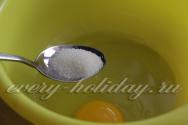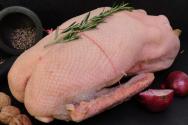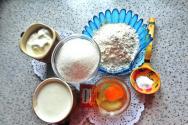How many minutes to sterilize cucumbers. A method of sterilization when canning (in this case, cucumbers). How to pickle cucumbers in sterilized jars
1. The other day I ran into a friend’s house and marveled at the painful process of sterilizing cucumbers. It was scary to see how much a person has to deal with boiling water - pour, wait, pour, boil, pour... And that’s not counting how labor-intensive it is!
Therefore, I decided to post my mother’s sterilization option, with which she has been canning both vegetables and compotes for more than forty years. I won’t even talk about volumes.
2. In this case, day X has come for cucumbers.
3. At the beginning of the process, pour about a little less than half of the water into a large saucepan and put it on the fire to bring it to a boil.
4. Prepare the marinade in a smaller saucepan. It’s most convenient for me to use 5 liters of water and bring to a boil.
5. While the water is heating up, put your favorite herbs and spices at the bottom of each jar. Then place the washed cucumbers tightly and add 1 aspirin tablet for each liter. That is, at 1 liter jar 1 tablet is enough. This must be done to prevent the fermentation process from starting later.
6. Pour hot brine into a jar and add acetic acid 1 teaspoon per 1 liter jar (cucumbers, not brine!), 2 tsp. for 2-liter, 3 for 3-liter.
7. Cover the jar with a lid and, using a grip, place the jar to sterilize in a large saucepan with boiling water, having previously placed a cotton rag on the bottom so that the bottom of the jar does not have direct contact with the bottom of the pan (due to the difference in temperature, the jar may burst). My saucepan can hold 5_ 1-liter jars, or 4 one-and-a-half-liter jars, or 3 two-liter jars at once. We cover all this beauty with a lid and leave to sterilize for a while at the rate of 1 liter jars for 8-10 minutes, 2 liter jars for 15 minutes, 3 liter jars for 20 minutes.
8. While they are being sterilized, we can put cucumbers in the next jars, prepare marinade, or do other interesting things. At the same time, I was cooking chicken, stewing new potatoes, and baking a pie in the oven. The main thing is not to forget about time.
9. The degree of readiness will be visible by the appearance of the cucumbers. – If you take out the jar after a while, the top part of the cucumbers will be a little yellower, the bottom ones will still be green. This is fine. Screw on the lid of the jar and leave, wrapped, until it cools (about 12 hours). During this time, the cucumbers will “reach”, but will not be overcooked, but will marinate, remaining crunchy.
10. For as long as I can remember, my mother always preserves only this way. And, there were never any swollen lids or spoiled products. There is no need to even talk about simplifying the process. There is no need to manically sterilize jars, lids, fill, drain.....
Perhaps my version will not seem new to many and it has been used for a long time. But after looking at several options for homemade preparations, I couldn’t pass it up and I suggest our chefs radically simplify this process.
Pickled cucumbers for the winter - crispy, tasty and juicy! Try this recipe - I will describe it in great detail, because the process is fascinating and I am 100% sure that a lot depends on the details, although many housewives have their own secrets and I hope you will actively share them in the comments, I am glad to participate in the discussion with you, dear readers)))
By the way, there is a recipe on the site - crispy and strong - try it))
Before we start canning, we buy dense green cucumbers of the correct shape, one to one:
- A three-liter jar takes approximately 1.8 kg-2 kg. cucumbers, we buy a little more, because you will sort through them and in any case there will be unsuitable “specimens”. Wash the cucumbers well and soak in cold water for 4-6 hours.
- Then we wash it again and sort it by size, cutting off the ends on both sides.
- Small fruits can be preserved in half-liter and liter jars.
Regarding sterilization - I’ve been using the oven sterilization method for a long time - it’s much easier and more enjoyable! We wash the jars well with soda and place them in a cold oven while still wet. We heat it to 120 degrees - heat it for 15 minutes (we'll see - the jars should become dry and hot) and turn it off. Do not remove it immediately, let it cool with the oven, you can open the door slightly after 10 minutes.
We also send the prepared jar with brine and cucumbers into the oven at 120 degrees for 30-35 minutes (here it depends on the volume of the jar, if it’s half a liter, then 10 minutes is enough), closed with a lid (but not screwed on). If you are afraid or are getting down to business for the first time, look into the oven - if the brine in a 3-liter jar has boiled, count 15 minutes from boiling and you’re done) It is advisable to place a baking sheet with water under the jars so that the brine does not “run away” into the oven when boiling) Then add vinegar and boldly twist the jars with pickles!
Required:
Crispy pickled cucumbers for the winter in jars:
For a three-liter jar:
- cucumbers – 1.8-2 kg.,
- dill – 20 gr.,
- bitter capsicum – 2 gr.,
- horseradish leaves or root – 20 g.,
- garlic clove – 6-7 pcs.,
- bay leaf - 3-4 leaves.
- medium sized green bell pepper.
- for 1 liter of water – 60 grams of coarse salt (you can use 2 heaped tablespoons if you have a cellar or a cool pantry for storage), peppercorns 5 pcs. and bay leaf 3 pcs.
- for a three-liter bottle - 50 ml of vinegar 6%.
- For a three-liter cylinder, depending on the arrangement of cucumbers and their thickness, approximately 1.5 liters of filling is required.
We fill a little more than 1.5 liters, again depending on how tightly the cucumbers are packed in the jar and their size, so as not to miscalculate the volume. Also, in order to get delicious pickles in a jar, you can add cherry and currant leaf, although I read different reviews about the latter, including not flattering ones, and I don’t add it, so I’m writing based on my own initiative)))
Pickled cucumbers for the winter in jars:
| To prepare delicious pickles in a jar for the winter, prepare the cucumbers themselves (the preparation process is described above), sterilize the jars in the oven and put all the spices indicated in the menu on the bottom of the jars. Boil lids for jars. |
|
| Fill the jars with cucumbers “by height” tightly one to one and prepare the brine. To make the brine, boil water, add salt and spices to taste and boil the brine for 5 minutes, then pour it into jars with cucumbers and put them in the oven for sterilization at 120 degrees for half an hour (if you are using three-liter jars). Carefully remove from the oven with a dry towel or silicone oven mitt, add vinegar “under the lid” and roll up the jars of pickles. Turn the jars upside down and wrap them until they cool completely) These are beauties! It was delicious, we ate it ourselves)))) Crispy juicy cucumbers - what we usually expect from twists)) Try it)) By the way, as they say, this is not the end)) I’ll expand the topic and write a separate article about all sorts of twists and turns)) It will be interesting))) |
|
 Lightly salted cucumbers in brine recipe - great
Lightly salted cucumbers in brine recipe - great
 Lecho recipe from bell pepper real jam
Lecho recipe from bell pepper real jam
 Cherry jam
Cherry jam
 Delicious jam cherry
Delicious jam cherry
 Salad “Bright Summer”
Salad “Bright Summer”
Good day to you, dear readers!!
Homemade preparations for the winter - preserves, jams, and eggplant caviar, pickled cucumbers and tomatoes, pickles - we most often store all this in glass jars. Compotes and juices are in glass bottles. And before you start canning, all containers must be thoroughly disinfected.
There are many ways to sterilize jars. I have chosen several of the easiest methods that can be performed at home quickly and easily.
- Carefully check the glass container for chips, nicks, and cracks. It is better not to use imperfect jars and bottles for preservation.
- New lids are needed for preservation. After all, we will be offended that our work in summer and autumn simply did not survive until winter due to poor-quality lids. Therefore, it is better not to skimp and buy new covers.
- When purchasing, we check the quality of the lids. Screw caps must not be bent or scratched. Lids with rubber bands should also be perfect with rubber bands inserted.
- We put chemicals for cleaning jars aside. They are difficult to wash off and are harmful to our health. Wash lids and jars with soda + mustard or laundry soap. We also use a new sponge for washing dishes.
Today in the article:
How to properly sterilize jars in the microwave
With this method, the lids are boiled separately in a saucepan.

- Wash jars and lids with mustard and soda. Wipe with a clean towel.
- Set the lids to boil separately on the fire for 5-7 minutes.
- We fill the jars with clean water 1-1.5 cm from the bottom.
- Place the jars in the microwave for 4-5 minutes at a power of 700-800 W. The water in the jars boils and steam sterilization occurs.
How to properly sterilize jars in the oven
One of my favorite ways. It's probably the simplest. You can sterilize jars along with their lids.
But it is worth noting that with this method you must have an electric oven with a thermometer. And lids for sterilization are suitable that can be screwed on.
For lids with rubber bands, the rubber band may dry out and burst or melt. Such lids must be boiled separately in water.

- Preheat the oven to 100-120 degrees Celsius.
- Wash the jars and lids well and place on a wire rack. You don't have to wipe the jars. Place dry jars with the neck down. We place the wet jars with their necks up so that all the water evaporates.
- Leave in the oven for 15 minutes. This time is for cans with a capacity of no more than 700 grams. For three-liter jars, more time is required - 20-25 minutes.
How to properly sterilize steam jars
This is also a convenient way to sterilize containers when you only need 1-2 jars. It’s also convenient because you put the lids in the pan and place a sieve or colander on top, on which the jars are sterilized. But I’ll start talking about this method in order.
1. Take a pan. The size of the pan depends on how many jars you will sterilize on it. The larger the volume of the pan, the more cans will fit on it. Pour water into it and put it on the fire until the water boils.
2. Wash jars and lids thoroughly. Place the lids in this pan and boil along with the jars.

3. When the water boils, place a sieve or steel colander on top. Place the jars on the sieve, neck down.
4. Boil jars like this: up to 700 grams - 6-8 minutes, liter and two-liter jars - 10-15 minutes, three liters and more - 20-25 minutes.

5. The jars were well sterilized when large drops of water appeared on them from the steam. Remove the jars and place them upside down on a clean towel to drain.
How to properly sterilize jars in water
Perhaps the easiest way to sterilize canning jars.

- We wash jars and lids with laundry soap.
- Pour clean water into a large saucepan or enamel bucket and place on fire.
- Place the lids and jars in the pan.
- Boil the jars for 6-7 minutes.
- Carefully, so as not to get burned, take out the jars and lids and place them bottom down on a clean, ironed towel.
Video - how to properly sterilize jars with blanks
And below is another way to sterilize jars in the oven, but with blanks.
That's all the simplest ways to sterilize containers for preservation. Successful and delicious preparations for the winter!
kerescan - Mar 22nd, 2015
Sterilization of full (filled) jars is another method for destroying microorganisms that contribute to rapid spoilage of canned foods, as well as sterilizing empty jars and lids. Sterilizing full jars is another way to keep homemade preparations for the winter safe and sound. And how to properly sterilize full jars.
To do this, we will place kitchen towels or other clean cloth folded in 5-6 layers at the bottom of a wide pan. Instead of fabric, you can use a specially made wooden lattice or circle.
Place jars filled with homemade ingredients on top of the fabric.
Pour warm water into the pan. The temperature of the water being poured must be no less than the temperature inside the jar itself, because If there is a large temperature difference, our jars may simply burst. You need to pour in enough water to cover the jars up to their shoulders.
We cover the jars with metal lids, but do not screw them on.
Cover the pan with a lid and let it boil.
After boiling, reduce the heat. During sterilization, the water should not be allowed to boil violently, as if it boils too strongly, it can get inside our jars.
After boiling, boil homemade preparations depending on the size of the jar. Sterilization time for full jars:
0.5 liter - 10-15 minutes;
1 liter - 20-25 minutes;
3 liter - 30-35 minutes.
When the sterilization time has expired, carefully remove the jar and screw it on.
After twisting, I usually turn the jars upside down and wrap them in heat until they cool completely.
This is how you need to sterilize jars with winter preparations (full or filled) at home.
You can see how full jars are sterilized in the video. Here, however, more attention is paid to the sterilization of jars with metal clamps, but this does not affect the principle of sterilization itself.
 Place all the seasonings on the bottom of the jar.
Place all the seasonings on the bottom of the jar. Pickled cucumbers in jars
Pickled cucumbers in jars






